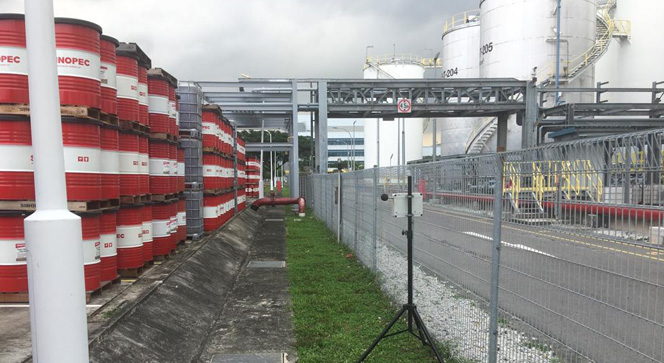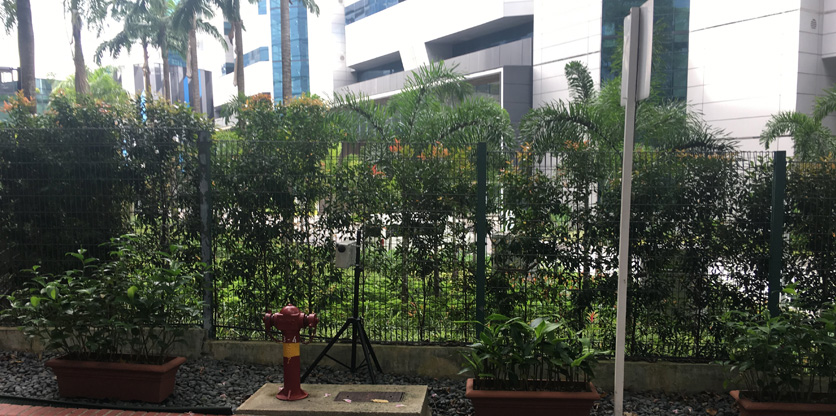Legal requirement for boundary noise monitoring :
As per Environmental Protection and Management (Boundary Noise Limits for Factory Premises) Regulations every occupier (factory license holder) of the workplace shall measure the noise level at their factory (workplace) boundary to ensure the noise level emitted from their workplace / premises shall not exceed certain limits as set in the law.
Qsafe Pte. Ltd provide Boundary Noise Monitoring Report in Singapore the most competent personnel for performing noise measurement. We are serving for various clients ranging from manufacturing industry, factory, workshops & petro-chemical industry.

Frequency of boundary noise monitoring:
Initial (first) mandatory boundary noise measurement shall be done and to be submitted along with Temporary Occupation Permit (TOP) application for the factory premises. The sound level measurement shall be done as per the direction given by the Director-General of National Environmental Agency. The duration of measurement also shall be advised by the Director-General through their letter to the occupier (factory license holder) or the owner of the premises. The occupier (factory license holder) or the owner of the premises shall measure the noise levels at specific distance, and time as advised by the Authority and submit the noise level readings including all the relevant facts that may influence the noise level measured (such as background noise). The Director-General may also advise the occupier (factory license holder) to measure the noise level at some specific points for specific duration due to the complaints received from the Public or nearby premises. In some cases the measured level shall need to be adjusted based on the background noises.
Qsafe Pte. Ltd provide the competent noise monitoring officer who is well experienced in differentiation the noise level emitted by the premises and the background noises and incorporate the findings in their boundary noise mapping report.Location / Point of boundary noise measurement.
The sound level measurement points shall be points at or about ground level along the boundary of the factory (creating noise) premises which faces any building on the affected premises; or if there is no building on the affected premises, any part of the affected premises.
If the affected building is within the same factory premises as the premises being monitored, the measurement point to be used shall be any point 5 meter from a wall of the premises being monitored which faces the affected premises.
The sound pressure level will be measured at 10-15 meter interval for each measurement point along the boundary of the client premises. The sampling will be conducted on the day Period (7:00 AM ~ 7: 00 PM) whilst a 24 hours continuous sampling regime will then be conducted at the potential highest Leq point where its corresponding Leq was recorded and referenced against NEA’s Permitted Boundary Noise Level.
Qsafe Pte. Ltd have experienced and competent noise consultants and they shall guide the occupier (factory license holder) or owner of the premises start from selecting the locations of measurement, interpreting measured readings on consideration of the background noise, preparing the boundary noise monitoring report and submission of the boundary noise monitoring report to National Environmental Agency.
Instrument to be used for boundary noise monitoring
As per the Director-General the measurements of noise levels shall be carried out with a sound level meter which complies with the standards specified in the International Electrotechnical Commission Publication 651 (Type 1) and Publication 804 (Type 1).
Qsafe Pte. Ltd shall use the calibrated sound level meter that complies with all the legal requirement as advised by the Authority.
Legal limits for boundary noise level at boundary
Legally permissible noise level may vary based on
- The adjacent premises / affected premises
- Noise sensitive premises
- Residential premises
- Commercial premises
- According to the background noise level
- Time of measurement (Different permissible noise levels set for different timings)
Qsafe Pte. Ltd provides you the most competent noise monitoring officer who is well experienced in identifying the factors explained above and interpreting the readings while preparing the boundary noise measurement reports.
Submission of boundary noise monitoring report to NEA
As Qsafe Pte. Ltd is an registered noise monitoring company, we shall submit the noise monitoring report on behalf of our clients.

Requirement of ISO 14001:2015 – Environmental management systems
Boundary Noise monitoring, also known as Environmental Noise monitoring can be defined as any unwanted sound and it embraces noise from industrial sources, transportation as well as from domestic premises. Environmental noise pollution can cause public annoyance and hearing impairment may result from high noise levels.
In the context of “The Planning Guidelines for Environmental Noise Limits and Control” published by Department of Environment, noise disturbance shall mean any sound which:
- Endangers or injures the safety or health of human or animals; or
- Annoys or disturbs a reasonable person of normal sensitivities; or
- Endangers or intrudes onto personal or real property boundary; or
- Exceeds the existing ambient equivalent A-weighted sound level; or
- Exceeds the sound level limits as prescribed herein in these Guidelines.
Measurements of noise levels are often necessary for any of the following purposes:
- Assessing the existing noise climate
- Assessing compliance to noise limits for noise source(s) and/or project development
- Assessing environmental impact and potential community response
Qsafe Pte Ltd offers accurate boundary noise levels measurement services at carefully selected locations to help our clients:
- Assess the noise levels of a particular site or region in accordance with the Planning Guidelines for Environmental Noise Limits for planning purposes and EIA study
- Assess the noise levels around an industrial site as a requirement of an ISO 14001 Environmental Management System
- Identify offending sound frequencies and to measure the sound levels of a specific noise source or a combination of noise sources for noise abatement purposes.
Permitted Boundary Noise Level
FIRST SCHEDULE
Table 1
|
Type of affected premises |
Maximum permitted noise level |
||
|
Day |
Evening |
Night |
|
|
Noise sensitive premises |
60 |
55 |
50 |
|
Residential premises |
65 |
60 |
55 |
|
Commercial premises |
70 |
65 |
60 |
|
Type of affected premises |
Maximum permitted noise level |
||
|
Day |
Evening |
Night |
|
|
Noise sensitive premises |
65 |
60 |
55 |
|
Residential premises |
70 |
65 |
60 |
|
Commercial premises |
75 |
70 |
65 |
|
Factory premises |
75 |
70 |
65 |
Note: if there are other sources of noise affecting the measurement of the level of noise emitted from the premises being monitored, the maximum permissible noise levels set out in the first schedule shall be adjusted in accordance with the Second Schedule and the adjusted value shall be taken as the maximum permissible noise level.
SECOND SCHEDULE
| The adjusted value of the maximum permissible noise level shall be obtained by adding the correction factor corresponding to the difference between the maximum permissible noise level in the First Schedule and the background noise level, set out in the Table below, to the higher of the 2 noise levels. | |
|
Difference between 2 noise levels in decibels (A) |
Correction factor in decibels (A) |
|
Below 2 |
3 |
|
2 to less than 4 |
2 |
|
4 to less than 10 |
1 |
|
10 and above |
Nil |

